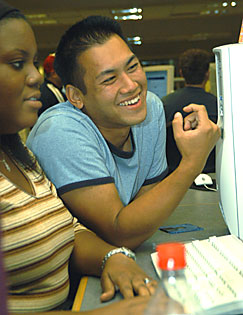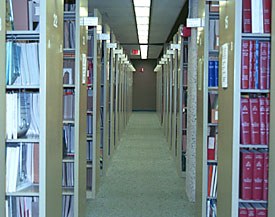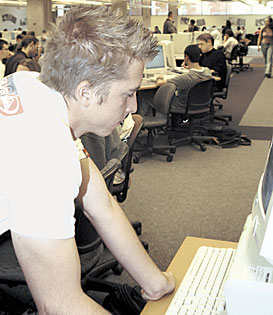 |
|
SAUL LOEB/Arizona Daily Wildcat
|
Business sophomore Bradley Lau and public administration sophomore Stephanie Thomas work on a PowerPoint presentation for their Math 115A class last night in the Integrated Learning Center, which has 221 computers with Internet access.
|
|
By Jesse Greenspan
Arizona Daily Wildcat
Wednesday October 16, 2002
Students access e-journals and e-books in the Integrated Learning Center, while books are left to gather dust on their shelves upstairs
Imprisoned by a chain-link fence this time last year, the Integrated Learning Center was bypassed by students during its construction.
After all, the more than $20 million haven for state-of-the-art computer technology stole the UA Mall from students for over two year.
But now, one year later, it's a part of most students' everyday lives. There they check their e-mail, meet with advisors and attend classes.
And despite the lack of what President Peter Likins has called the center's "technological apex" ÷ the Media Center that never opened due to budget cuts ÷ the underground glass and steel structure is running smoothly and to the liking of students, even the upperclassmen who held their nose up at it when it was just a dirt hole in the middle of campus.
The ILC was designed to be an extension of the library, its Information Commons stretching down from the basement of the building and showcasing more than 200 computers.
But so soon after its January grand opening, the center is not known as "the library's basement." Instead, the library has become an attic to the ILC, housing remnants of the past ÷ books.
Just one year ago, the library had around 75 computers and only 12 of them had significant amounts of software, said Robert Mitchell, an undergraduate services librarian, who has worked at the UA for more than 25 years.
With the opening of the ILC, the library currently has 221 computers, all of which contain full Internet capability and a wide variety of software, including Word, PowerPoint, Excel, Photoshop and DVD players.
"It didn't take the students long to realize the place existed and to realize it was a cool thing," Mitchell said.
Yet despite the seemingly endless advantages to the computer age, books have not been a part of the library's recent development.
More and more students have instead been looking things up on the computer, and have avoided shifting through the nearly 5 million books on the library's shelves.
That, the library staff says, is in response to student trends and tighter budgets.
 |
|
SUSIE LEMONT/Arizona Daily Wildcat
|
Shelves of government documents sit untouched on the fourth floor of the Main Library. Online resources are more cost effective for the library.
|
|
Buckle your book bag
When Mitchell first started working at the UA library in March 1976, computers were not a part of the library scene.
But over the past 26 years, things have certainly changed.
"If you had walked into (the library) the day it opened in 1977, you wouldn't have seen any computers," Mitchell said. "There just weren't any."
For psychology junior Maria Carrizoza, the library's computer wave has equaled convenience.
"Everything I have had to read (for class) has been on electronic reserve," she said. "One of my classes doesn't even have books. It's all on the computer."
With the wide variety of information online, many students feel they no longer need to use books for research.
"I like looking something up online rather than (using) books," business sophomore Rudy Gallego said, who estimated he used the ILC's computers three or four times a week.
He is not the only one.
In 1995-1996, 1,048,000 books were checked out of the library and another 1,090,000 were used in the library itself.
By the 2001-2002 school year, only 731,624 books were checked out and 791,000 books were used in-house.
This reduction could be attributed to the fact that all dorms became wired for the Internet, dean of libraries Carla Stoffle said, allowing students to do off-location research.
"Computing is a tool that allows us to disseminate information and to make information available," dean of libraries Carla Stoffle said. "And it allows us to do it better and faster."
The library itself has turned toward the online world, and is committed to having as much information as possible online, Mitchell said.
"It saves us the storage and is something students in particular really like," he said.
 |
|
SUSIE LEMONT/Arizona Daily Wildcat
|
Ben Williams, a biochemistry and molecular biophysics junior, prints out materials in the Information Commons. The library has more than 35,000 e-journals available for students.
|
|
In fact, in five or six years, Mitchell estimated the library would experience static growth, in which the number of books would remain stable due to spatial constraints.
Once that occurs, the only way the library can expand is through e-books, which it gets almost exclusively through netLibrary, a company that distributes electronic books to libraries across the country.
The UA library currently has 19,556 e-books through netLibrary.
The number of print journal subscriptions has dropped, undergraduate services librarian Laurie Eagleson said, although they still outnumber e-journal subscriptions by more than 4 to 1.
"Many students turn first to see if something is online," Stoffle said. "The faculty need to help students understand· just because something is on the web doesn't mean it's correct."
However, this has not stopped students from using the web in greater and greater numbers.
When the Online Computer Library Center did a national survey of 1,050 college students, nearly 80 percent said they used Internet search engines for "every" assignment or for "most" assignments.
For Carl Berkhout, an associate professor in the English department, electronic and print resources need to go hand in hand.
"The electronic stuff, in some instances, can replace books," he said. "(But) In many ways, it only supplements (books) and a good research student knows how to use both."
And when it comes to higher-level research, Berkhout would prefer to see students sifting through the library's bookshelves.
"(Computers) are a good supplement at the undergraduate level," he said. "But graduate students still have to have to be mindful of traditional sources that are not yet obsolete."
The library staff would also like to see students use more books and print journals
But that's not what's happening.
In 1995-1996, the number of people visiting the library peaked at 1,964,000. The next five years saw a dramatic drop in visitors, with only 1,500,000 flowing through in 2001-2002.
Checking Out
Library circulation at the UA hit its peak in the mid-1990s, but dropped in response to the availability of online accessible academic journals through the library Web site coupled with Internet access in the dorms.
Circulation
1991-1992: 842,515
1995-1996: 1,048,000
2001-2002: 731,624
Traffic
1995-1996: 1,964,000
2001-2002: 1,500,000
In-house use
1995-1996: 1,090,000
2001-2002: 791,000
Source: UA Libraries
|
As the dust settles
Breezing through the ILC yesterday, Blake Sine, a senior majoring in English, said the advance in technology that the center showcases has been a step in the right direction.
"(The library) definitely has everything I've ever needed for any sort of research paper," he said. "The online archives are really helpful. It is a lot easier looking up (an article) online than on microfiche."
And although Sine's outlook reflects the common trend, spatial constraints and library-dweller trends are not the only thing influencing the switch to electronics.
While the library has not suffered from the budget crunch as much as many departments at the UA, the budget for buying information, namely books, journals and electronic materials, has remained stable.
Getting online journals at the expense of print journals is one way to save money.
E-journals are similarly priced to print journals, and range from $100 to $10,000 per year. Money is saved, however, by sharing e-journal costs with other libraries, Eagleson said, and through a reduction in staff time needed to check, label and shelve each individual journal.
The library currently spends $7,575,000 annually on information, with $3,382,000 of that going toward print journals. The rest of the budget is spent on new books ($2,256,000), electronic materials ($1,737,000) and special formats ($200,000), which includes videos and maps.
The library currently has access to 11,327 additional e-journals through a consortium with other universities.
"For our library users, there is really no difference between these and the e-journals we actually subscribe to," Eagleson said. "The bottom line is that they have online access to all of them."
As a result of these online journals, the total number of journals available to students has actually significantly increased to a present-day total of 35,333, Eagleson said.
And with the expanding role of computers in the library, the task of each individual librarian has become more complicated, Mitchell said.
"(Computers) give us the ability to multitask in so many ways they have certainly changed the ways librarians do their work," he added. "We still have subject specialization but more and more people have to be generalists as well as specialists."
Subject specialists do exist at the library, but even they have to be prepared to answer general questions.
"A librarian could work in the history department and be an expert in history, but they would also have to work at the help desk and answer questions about psychology, for instance," Mitchell said.
As a result of budget constraints, 13 of 200 positions were cut last year, Stoffle said, and more cuts could happen in the future.
With fewer librarians working at the library, some special services previously offered will undoubtedly face elimination, Stoffle said.
"If we lose a certain percentage of the staff, then we all have to work that much harder to do all the work," Mitchell said. "Or we will have to make some very difficult decisions about what we need to stop doing."
In a web-based survey, the library staff found that students are using a variety of resources, said Janet Fore, the leader of the undergraduate services team.
The survey also found that email, studying and class assignments are currently the top three reasons for visiting the Information Commons.
This survey will be performed on a yearly basis to see what additional resources students need, Fore added.
One thing that could be needed are even more computers, as lines were already forming by the second or third week of classes this year, Mitchell said.
With all of this focus on technology, the library staff has not completely forgotten about books.
"Everything is not computerized, and we still have millions of books," Mitchell said. "And we're not going to get rid of books. It's not only about computers."
Stoffle agreed. "If I had my druthers I would prefer to focus on print and owning things in hard copy," she said. "But I don't have that luxury. We have to make the budget stretch as far as it can."
And at least for now, says Stoffle, budget constraints not seem to be impairing students' needs. In fact, they seem to be a "luxury" for them.
"I come to (the ILC) three to four times a week," pre-business freshman Monique White said. "Basically, they have the Internet and that's all there is to it. I wish they would get more computers. I wouldn't be waiting here right now."

